|
UK Railways : Derailed for good
?
The last few years have
been a sorry tale for the UK rail industry. With periodic train crashes
across the network, there have been calls for the whole network to be
brought back under the control of the public sector - not that such
a 'buy-back' is financially feasible anymore.
Today, the UK rail network is suffering from over 50 years of
under-investment and utter neglect, as a result of every single UK post-war
government. There is though a lot of 'work in progress' in the current rail
network, and it could be said that in 15-20 years the UK rail network will
be relatively stunning compared to its current state.
Stretched to capacity
In January of 2003 the UK rail operators agreed to actually cut back on
some services, in order to make the service more reliable. It is clear
that over the last few years as passenger numbers have increased (as UK
government policy intended) that the rail network has reached its full
capacity. With current technology and other aspects considered, it is
simply not possible to cram any more trains on to the existing network.
With this fact in mind, it is therefore necessary to face the necessity
of expanding upon the existing network, not simply ploughing more money
into what already exist.
A Metro underground system for the UK
I have always been impressed with the London Underground,
structurally speaking that is. The London metro system runs for 243 miles
of which approximately 42% is tunnelled rail. It is also useful to realise
that the London network continues to expand, this is especially true for
lines in the east end of London. The actual operation of this underground
metro system does leave a lot to be desired though, and I believe is
poorly managed. However the actual engineering of the underground itself
remains hugely impressive. This is especially so when consideration is given to
the fact that most of it was dug out a century ago.
A Bold proposal for the 21'st century
As things are, as long as the current UK government's investment in
transport policy is followed through this decade, the quality of existing
transport network should improve - if somewhat slowly. However, we cannot
ignore the fact that the overall transport network is already bursting at
the seams.
I believe it is time for the UK to have a new high speed mass
transit link. This high speed link would connect all the main UK
population centres together. Currently, both the road and rail network are already beyond
their rated capacity. It is simply not feasible to expect any more trains
or cars to use the existing transport links. What is instead required is
an additional transit link network.
Lets Go Underground
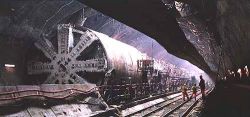
A typical tunnel boring machine- Yucca Mountain, USA
A high speed link underground, does that sound crazy ? Well, there
is already a precedent of course,- the channel tunnel link. The 'Chunnel'
stretches for 31 miles, which makes it one of the longest tunnels in the
world. The idea of a tunnel running 102 miles might seem truly mad though.
However, again there is a precedent - the London underground network
(tunnelled section) amounts to around 140miles. So, the issue is not
whether the project can be done, but if it should be done.
Benefits of Underground tunnelling
- Planning/legal issues, far simpler, less prep. time needed
- No issues about building near housing/industry.
- Travel, the quickest route is possible via a 100% straight route.
Flying trains
The days of trains with
screechy wheels, and track which must regularly replaced, are coming to an
end. Any new transit 'rail' system must be progressive, Magnetic-levitation
(Maglev) technology is the only way to proceed in this respect.
Maglev transportation has finally come of age. China has
recently shown the way ahead in terms of mass transportation. The new
shanghai-Pudong Intl. Airport link has just been completed, and is
probably the most advanced means of transportation in the world. Using
Magnetic levitation the train carriages float just a fraction of an inch
above the track. The trains can reach astonishingly fast speeds of 440kmh
(273mph) and even faster speeds are possible where the track is straight.
At Lathen in north-west Germany in the past
14 years; they have been test-operating maglev trains, which over the
years have clocked up more than 700,000 kilometres in trials. The German maglev
train has a maximum design speed of 550kmh (that is 341mph !).
In fact, there is no real limit to how fast these things can
travel. In Japan, 2 maglev trains passed each other, each travelling at
over 500kmh, meaning a relative speed contrast of over 1000kmh ! Amazing
indeed, and the technology is continuing to be refined and improved. With
the Chinese leadership's decision to invest in Maglev transit (possibly
nationwide), the technology is sure to improve at an even faster rate over
the coming years.
Driverless trains
With the level of technology as it is, there is absolutely no need for
train drivers. For instance, just look at how well London's Docklands
light Railway operates. Not a single driver on any of it's network,
everything is run at special control centres.
It makes no sense to pay people to drive trains, when it can be all
done from a central/regional command centre. In order to maximise the
number of trains on the line at any one time, a fully computerised system
is the only way to fully utilise the capacity of the new lines. Arguably,
having computers take over the control of trains is more safe than leaving
it to humans, who inevitably make errors from time to time.
Engineering on a Grand Scale
I envisage a countrywide engineering plan, on a scale that even the great
engineer Brunel would be proud of. Once the first link has been completed,
the shear popularity and speed of the line will see the mass population
demand a nationwide network be established. Public support for such a new
method of transit across the UK will be necessary if the project will
become self-financing in the longer term.
The task involved in boring such long tunnels will be no different
than that involved in any other major tunnelling project. The technology
is available now, both the ability to tunnel efficiently and the new
Maglev mode of travel are ready to be applied. The overall plan I propose
can be split into two main stages.
The Beginning
Stage one of the overall plan calls for a London-Birmingham link.
Birmingham is arguably the second capital of the UK, and thus merits the
primary stage of the plan. The link itself would
amount to a distance of around 102 miles. This would indeed be the longest
man-made tunnel in the world. Note that exact distances are based on
straight line links, precise numbers would depend on where each mainline
station would be placed in each city.
Station location.
The stations themselves should be as close to the centre of the
main population centres as possible. Other mitigating issues are of
importance though. The stations should be close enough to existing primary
transport hubs. In the case of London, it would be very tempting to locate
the Station in the Kings X/Euston area, rather than the actual city of
London itself. In any case, the station would be need of a
significant size, in order to meet the expected passenger numbers.
The station structures could be based entirely underground, or a
combination of surface/sub-surface design.
How fast can tunnelling proceed ?
Tunnelling speed depends on a variety of factors, not least of
which is the material being drilled through. However, a rough guide can be
used to formulate some initial time line of events.
The British-French channel tunnel was constructed at a rate as high as
250ft per day. A review of companies specialising in tunnelling, suggest a
daily tunnelling rate of around 150-250feet a day. This equates to about
0.0474 miles per day. Assuming a 5 day standard week, that is 0.237 miles
per week. Assuming 50 weeks of tunnelling a year that is 11.85 miles a
year.
For this project to work, multiple teams will need to be in place. I
suggest a minimum of 3 teams to complete this first stage. Each team
completing roughly a third of the 102mile route.
Noting that one team will
likely tunnel around 10-12 miles a years (assume a conservative 10 miles
per yr), a distance of around 102 miles will take the three teams about
3.5yrs.
Personally, I think 3.5 years is extremely fast for such a project.
Station construction will in itself take a few years, although this should
be run concurrently with the main tunnelling teams.
Overall, I would argue that the project should take no more than 4-5 years
to complete. Planning issues, surveying, and other preliminary assessments
should be permitted to take no longer than 2 years.
* Note that the 'tunnel' is actually comprised of 3 actual tunnels,
2 main ones for the actual passenger trains, with a service tunnel between
them. This is exactly the same configuration as used in the Channel
tunnel, offering a reliable means of maintenance and safe escape.
Stage 2 and Beyond
As the final sections of the London-Birmingham link are being completed,
a new team should already have begun to extend the line from Birmingham
northwards to Manchester.
Assuming 2 teams working on this link, we are looking at around another
3-4 years for this link to be completed.
Linking the Far north of the UK to the capital is going to be an almighty
task for the engineers to complete. To complete a London to Glasgow link,
we are looking at a time span of somewhere on the scale of 12-15 years.
Cross linking other smaller cities will then become the next task for
constructors. Connecting up all the main population centres, including
Leeds, Liverpool, and Nottingham and other nearby cities.
Also, a new link from London westwards should be established running along
the main M4 'urban corridor', all the way to Cardiff.
Financing the UK Metro Plan
The plan outlined is indeed bold, but how much would this cost the
UK taxpayer ? Would such costs be justified by benefits to the UK
traveller and economy as a whole ?
The channel tunnel cost £9 billion (at 1994 prices) for the 31mile
stretch. What could we expect the London-Birmingham link to cost ?
As an amateur economist (amongst other things) I would suggest at least
£15 billion per 34 mile section. Hmm, how does that sound ? That makes a
rough figure of £45 billion for the first stage of the overall plan.
Personally, I consider ALL expenditure on such grand engineering projects
as entirely justified. Once built, the network will last for centuries.
The running costs of the network once built would be made to be
self-financing. Commuting fares should be representative of the investment
in the line.
Economically speaking, long term borrowing for capital investment can be
justified - although allocated investment must be efficiently used.
Once Stage 1 is complete, and is fully operational, ALL income from
commuters should be set aside to finance the costs of further
development.
Other options ?
It is of course possible that other network options could be selected. A
combination of tunnelling and surface rail perhaps. Surface rail would be
much cheaper, however the logistics of building a new surface line are
complex and opposition to building anything anywhere in the UK would make
the Maglev plan potentially bogged down in a bureaucracy of planning
groups.
The simplest way to connect two places in a highly urbanised country will
forever be a straight line tunnel.
The Future of UK Transport
The future for the UK transport network could be a spectacular one,
or it could remain as it is, stretched to capacity, poorly managed, with
relentlessly poor levels of capital investment. What seems paramount right
now are new transport links.
A nationwide Maglev transit system would provide for the first
time, the means to get to other cities almost as quick as travelling by
air. The construction costs involved are indeed immense, and would
constitute the single largest capital project ever attempted in the UK.
Yet the UK commuting public are aching for a decent transport network. The
benefits in less congestion are clear. The ability to hop on a train and
cruise across the UK at 300mph cannot be overstated. The UK commuter
deserves a new means of transport, Maglev seems the most logical option to
take.
What I have proposed here in this summary article, may sound far fetched and unachievable. Yet the Channel tunnel was completed with immense
engineering success, despite the many people who once said it could never
be done. The UK public deserve a metro system fit for the third
millennium, not the 19'th century. It is time to expand the UK transport network,
it is time for the UK Metro
system.
Contact Calrissian
Return to

© 2003 Philip Calrissian
Last Updated :
04/01/05
|
World Population : 6.27 billion as at Feb 4'th 2003
US/World population clock
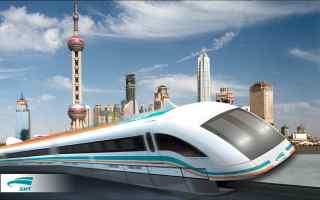
Artist impression of Shanghai express
Photo : www.transrapid.de.
Related Websites
Network Rail : Non-profit
company managing the UK's rail network of tracks and stations
SRA- Strategic Rail Authority,
for the UK's network
Dft - Dept for Transport :
UK' govt. website.
State of the Railways : BBC online rail section

Special articles
Transrapid Intl :
Flying on the Ground
Wonders of the World : The Channel Tunnel
Rail Technology : Beijing-Shanghai high speed link

Shanghai, China : Mag-Lev station
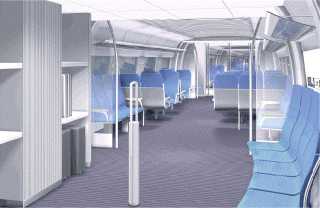
Artist conception of interior of a 'regional express'
Photo : www.transrapid.de

Stage 1 : Southern Metro Plan
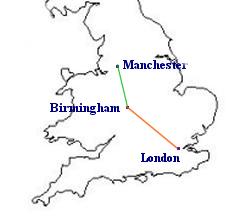
Distances involved (as the crow flies)
London-Birmingham : 102 miles
Birmingham - Manchester : 70 miles
Stage 2 : Midlands/North Metro Plan
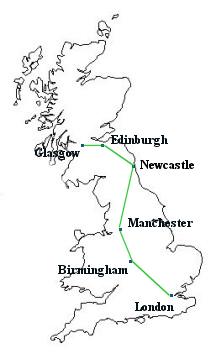
Distances involved (as the crow flies)
Manchester - Newcastle : 108 miles
Newcastle - Edinburgh : 90 miles
Edinburgh - Glasgow : 49 miles

The 3 Teams involved in Stage 1, each working 34miles of the route, taking
3.5 yrs to complete.
Beyond Stage 2: Extending the network
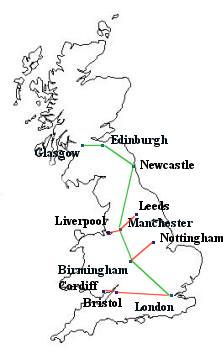
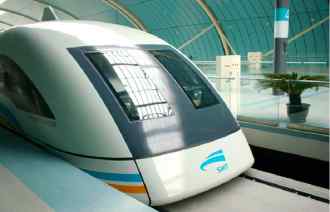
SMT Maglev Train, Long Yang road station
Shanghai. Photo : Transrapid rail.
 |











